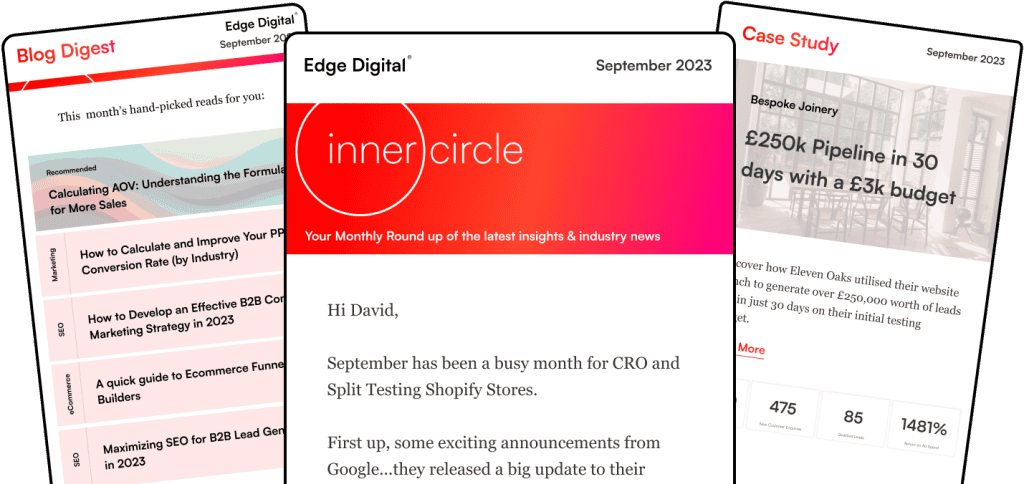When it comes to online advertising, Bing Ads and Google Ads stand out as the two major players in the industry. Google commands a significant portion of the global search market, making it a dominant force in online advertising. Each platform offers unique advantages and challenges, compelling businesses to scrutinise which will best meet their marketing objectives. While Google Ads has long been the dominant force in the market, Bing Ads provides a compelling alternative that can align with particular advertising strategies. Our analysis in this article will lay a foundation for understanding how both platforms operate, the nuances of their reach, and the effectiveness they may offer in terms of visibility and customer acquisition.
As advertisers, we must consider factors such as cost, targeting capabilities, and the overall return on investment when choosing between Bing Ads and Google Ads. Budget constraints and audience targeting play crucial roles in this decision. Evaluating the performance metrics, ad formats, user experience, and the analytics provided by each platform aids us in developing a sophisticated and practical advertising approach. By understanding these elements, we can optimise our campaigns for the highest possible impact.
Key Takeaways
Both Bing Ads and Google Ads offer distinct benefits for online visibility and customer acquisition.
Critical evaluation of performance metrics and targeting options is essential for optimising ad spend.
Selection between the platforms should align with specific advertising goals and budget considerations.
Understanding the Basics
As we explore the landscape of online advertising, it’s essential to grasp the core features of Bing Ads and Google Ads, two leading platforms in the digital advertising realm. Let’s dissect the functionalities and key differences that set them apart in the competitive search engines market.
What Are Bing Ads?
Bing Ads, now rebranded as Microsoft Advertising, serve as our gateway to access the audience on Bing, Yahoo, and other Microsoft network sites. These advertisements appear beside search results when potential customers perform a search on the aforementioned engines. With Bing’s integration into Windows-driven devices and Microsoft’s suite of products, the reach is considerable, albeit not as vast as Google’s.
Overview of Google Ads
Google Ads is the predominant advertising platform that allows us to place ads across Google’s extensive search engine network. Google Ads campaigns offer various match types and expansive reach in terms of language targeting, making them a superior choice for many advertisers. Leveraging Google’s dominance in the search engine market, these ads are displayed alongside search results, on Google-affiliated websites, and throughout the Google Display Network, targeting users based on their search queries and browsing habits.
Key Differences Between Bing Ads and Google Ads
The main distinctions between Bing Ads and Google Ads lie in audience demographics, cost, and functional capabilities. Google Ads generally offer a broader reach due to Google’s larger market share. Conversely, Bing’s audience often includes an older, more affluent demographic that can yield higher conversion rates for certain industries. Cost-wise, Bing Ads can be more cost-effective with lower cost-per-clicks compared to Google, which may appeal to businesses with a tight advertising budget.
Furthermore, while both platforms use a similar pay-per-click model, they differ in ad placement strategies and keyword matching options. Bing Ads provides more granular control at the ad group and campaign level, which can affect how we manage budgets and experiment with ad copy. This level of specificity in targeting and budget allocation can profoundly influence the performance and effectiveness of our marketing campaigns.
Market Presence and Reach
In assessing the effectiveness of advertising platforms, we must consider their market presence and reach. Google commands over 83% of the global desktop search market share, making it a dominant player in the search market. These factors determine the potential audience and impact of our marketing efforts.
Search Engine Market Share
Google remains the dominant force in the search engine market, with a substantial portion of global search queries. Bing, while smaller in size, still commands a notable share, especially when combined with search queries from network partners like Yahoo and AOL. According to recent data, the average cost-per-click on Bing Ads can be substantially lower than Google Ads.
Google Search Engine Market Share: Predominant Bing, Yahoo, and AOL Market Share: Significant, but smaller
Audience Demographics
The demographics of Bing users tend to skew towards an older age group with slightly higher average incomes, which can be advantageous for certain market segments. Google’s audience is more far-reaching and diverse, given its sheer volume of users. When looking into audience demographics, we focus on aligning our product or service with the platform that best mirrors our target consumer profile.
Bing: Older demographics, higher income Google: Broad and diverse user base
Network Partners and Extent
Google’s advertising network extends beyond its search engine to include vast numbers of partner sites, providing extensive reach across various search engines. Bing’s ad network, while smaller, benefits from strategic partnerships with Yahoo and AOL, enhancing its reach. These partnerships are crucial as they allow ads to appear on a wider array of sites, thereby increasing the potential touchpoints with our audience.
Google Network: Extensive Bing Partner Sites: Strategic (incl. Yahoo and AOL)
Campaigns and Ad Targeting
In the world of online advertising, setting up efficient campaigns and honing in on your target audience through detailed targeting options are pivotal for the success of your ads. Google Ads campaigns allow for detailed segmentation and targeting, making them a powerful tool for advertisers. We will explore the specifics of campaign setups and the breadth of targeting capabilities available in both Bing Ads and Google Ads.
Setting Up Campaigns
We begin by establishing our campaigns, which is a top-level organisational feature that allows us to segment our advertising efforts based on products, services, or other categories significant to our business objectives. Google Ads campaigns offer a range of features such as ad scheduling and ad rotation, which can be customized at the campaign level. Both platforms require us to define campaign parameters such as budget, language, and location. In Google Ads, settings like ad scheduling and ad rotation are determined at the campaign level, with ad groups inheriting these choices.
On Bing Ads, which has been rebranded to Microsoft Advertising, we find more flexibility as it allows us to adjust these settings even at the ad group level, presenting opportunities for granular control.
Targeting Options
Targeting the right audience is key, and here, both Google Ads and Bing Ads offer robust capabilities. Through the use of keywords, we can connect with users searching for specific terms relevant to our offerings. Both platforms also enable demographic targeting, which includes age, gender, and more recently, household income, ensuring we can reach the customers most likely to find our products or services appealing.
While Google Ads has a more extensive reach due to its larger market share, Bing Ads allows for a unique targeting advantage; it enables us to target by device type at the ad group level, granting us more precision in aligning our ads with our audience’s usage patterns.
Language and Location Targeting
Our campaigns must speak the language of our audience, literally and figuratively. As such, Google Ads and Bing Ads both allow us to specify the language of our ads. However, Bing provides the added benefit of allowing language targeting at the ad group level, giving us a finer level of control compared to Google’s campaign-level language settings.
Location targeting is equally important as it ensures our ads appear in the geographical regions pertinent to our business. Both platforms offer comprehensive location targeting options, from country-level right down to postal codes or radius around a specific point, aligning perfectly with our aim to reach potential customers in the most relevant locations.
Cost and Budgeting
In assessing the financial planning of ad campaigns, we recognise that understanding the intricate balance between cost and performance is paramount. Let’s explore the most pivotal aspects of cost-effectiveness, CPC, and managing our ad budget when it comes to Bing Ads versus Google Ads.
Cost-Effectiveness
We often measure the cost-effectiveness of a PPC campaign by its ability to achieve the desired outcome within a reasonable budget. Google Ads are typically known for their expansive reach, but Bing Ads can be up to 70% cheaper in terms of cost-per-click (Bing Ads vs. Google Ads: The Pros & Cons of Each Platform – Instapage). However, it’s worth noting that while the individual cost might be lower on Bing, Google Ads often boast a higher volume of traffic, which may lead to increased overall costs.
Understanding CPC
Cost Per Click (CPC) is the fee we pay each time our advert is clicked. It acts as a solid indicator of the competitiveness within the market and the relative value of certain keywords. Bing Ads can provide us with a lower average CPC in specific industries, e.g., automotive, where the CPCs are 32.5% lower than Google’s, and in insurance, a reduction of 59.2% is noted (Bing Ads vs. Google Ads: The Pros & Cons of Each Platform – Instapage).
Managing Ad Budget
Efficiently managing our ad budget ensures that we maximise return on investment. Both Google Ads and Bing Ads offer tools to control daily budgets effectively; however, they differ slightly in their approach to bidding and pricing. For instance, Google Ads may involve a more competitive bidding environment due to higher traffic volume, which influences our budget allocation. Conversely, with Bing’s lower traffic, our daily budget may stretch further but potentially reach a narrower audience.
Performance and Conversion Metrics
In evaluating Bing Ads versus Google Ads, we’ll focus on how these platforms track key performance indicators and drive conversions. A critical look at click and impression data, conversion rates, and the return on investment will spotlight the distinctions in their performance metrics.
Tracking Clicks and Impressions
We understand the importance of monitoring how often our ads are displayed (impressions) alongside the frequency they’re actually clicked on (clicks). The click-through rate (CTR) tells us a great deal about the effectiveness of these ads. Google Ads typically showcase a robust click-through rate due to their vast user base and advanced ad placement algorithms. On the other hand, Bing Ads can provide higher visibility for certain keywords due to a less competitive landscape, as Bing’s ads are prompted higher in results than those of Google Ads.
Conversion Rates and ROI
When we assess conversion rates, we’re looking at the percentage of clicks that result in a desired action, such as a sale or a signup. It is critical for us to optimise this metric to maximise our return on investment (ROI). Google Ads has been noted to have a higher conversion rate on average, while recent trends suggest an increment in Bing’s conversion performance. For instance, industry numbers suggest that vehicles stand out on the search network with a high conversion rate on Google Ads.
Engagement and Traffic Metrics
Lastly, we review engagement and traffic volume metrics to gauge user interactions beyond clicks and impressions. The traffic generated by ads plays a significant role in our overall marketing success. While Google Ads might drive larger traffic volumes due to its extensive network reach, Bing Ads often boast a demographic that can lead to more targeted engagement. It’s crucial for us to evaluate which platform aligns better with our advertising objectives, considering both overall traffic and the quality of engagement.
Ad Formats and User Experience
When comparing Bing Ads and Google Ads, it’s pivotal we recognise the distinct differences in ad formats and user experiences both platforms offer. These variations largely influence the effectiveness and engagement levels of pay-per-click (PPC) advertising campaigns.
Search vs Display Ads
The Search Network encompasses text-based search ads that appear in search results. Text ads are a foundational element of search advertising, with specific guidelines and character limits that must be adhered to. Google Ads often boasts a higher frequency of search traffic, providing extensive visibility. Google’s ads integrate seamlessly with vast search queries, capitalising on their dominant market share. Meanwhile, Bing Ads cater to a more mature audience and exhibit lower competition for keywords, which can result in a cost-effective alternative for advertisers targeting specific demographics.
For display ads, Google’s Display Network covers a diverse range of websites, allowing ads to reach over 90% of internet users worldwide. This ample coverage affords advertisers with Google the opportunity to engage audiences across various digital spaces. Bing, operating with a smaller display network, may not offer the same reach but can yield a dedicated and high-value audience in particular sectors.
Shopping Ads and Extensions
Google Shopping ads provide users with immediate product visuals directly in search results. App ads allow businesses to promote their mobile applications across various channels, including Google’s Display Network and other partner sites. Google’s platform is highly efficient for these ads, largely due to its broader user base and advanced ad extensions that enhance listings with additional information like ratings or price. On Bing, shopping ads are comparably less prevalent but can offer reduced costs and cater to audiences not covered by Google.
Both platforms support a range of ad extensions, which are crucial in improving ad visibility and engagement. We see descriptive texts, call buttons, and location information commonly utilised to provide users with helpful details at a glance, potentially leading to higher click-through rates.
Ad Copy and Creatives
A well-crafted ad copy can be a game-changer. Both Bing and Google require concise, relevant, and compelling ad copy complemented by creative descriptions. Google’s expansive ad platform allows for high creativity and innovation in ad formats. On the other hand, Bing’s differentiators include unique options in ad targeting and a less stringent approach to character limits, which can give advertisers more space to convey their message.
We observe that ad creatives must resonate with the targeted audience to ensure conversions. This involves clear messaging and visual appeal in line with the user’s search intent or browsing behaviour. With both platforms enabling extensive targeting options, curating ad copy and creatives that align with the audience’s preferences is critical to our success in PPC advertising.
Tools and Analytics
In our deep dive into Bing Ads versus Google Ads, we examine the comprehensive analytics, versatile dashboards, and integration facilities each platform offers. These tools are critical for optimising our paid search strategies and making informed decisions regarding ad placement, scheduling, and rotation.
Dashboard and Reporting
When using Microsoft Ads, we encounter a dashboard that provides us with a streamlined overview of our campaigns. It includes metrics like click-through rates (CTR) and average cost-per-click (CPC). For a more customised approach, we can generate reports tailored to the specific aspects we’re most interested in monitoring.
Google Ads takes a slightly different approach with a highly detailed dashboard that integrates with the Google Display Network, allowing us to track a multitude of variables. It is particularly effective for keeping an eye on the performance across different networks and devices, making our reporting both comprehensive and insightful.
Integration with Other Platforms
Integration is key for the efficiency and effectiveness of our ad campaigns. Microsoft Ads shines in its ability to integrate within the broader Microsoft ecosystem, including platforms like Microsoft 365 and LinkedIn. This ensures that we can harmonise our advertising efforts with our existing productivity tools and professional networks.
On the other hand, Google Ads offers its powerful integration with Google services, such as Google Analytics and YouTube, enhancing our ability to track and analyse our data. This allows us to fine-tune our campaigns based on user engagement and content performance, a vital part of our strategy on the Google Display Network.
Using Analytics for Optimisation
Our analytics give us the insights needed to refine our ad scheduling and rotation strategies. For instance, by analysing the data collected, we can schedule our ads to run at the most efficient times, thus maximising our budget and increasing our return on investment.
Likewise, with Google Ads, we harness the power of detailed analytics to better understand how our ad placement affects our overall campaign performance. This level of detail helps us make data-driven decisions that can significantly improve our paid search outcomes.
Strategic Considerations
When choosing between Bing Ads and Google Ads, we must weigh several strategic factors. The right choice can significantly enhance our visibility and improve the efficacy of our marketing efforts.
Choosing the Right Platform for Your Audience
Identifying where our target audience spends their time online is crucial. Google Ads offers unparalleled reach due to its dominating presence on the search engine results page, with a significant market share. However, Bing Ads can provide access to a unique demographic that may be overlooked by our competitors.
Competitive Analysis
In deploying our campaigns, a thorough competitive analysis is essential. Bing Ads, with its generally less competition, may lead to lower cost-per-click (CPC) rates. On the flip side, Google Ads, despite potentially higher costs, can offer broader visibility, potentially leading to a higher volume of traffic.
Long-Term Digital Advertising Strategy
Our approach to digital advertising should be sustainable over the long term. Google Ads has been known for its robust analytics and optimization tools, which can be instrumental in tweaking our campaigns for better performance. Meanwhile, the lower CPC on Bing Ads can be advantageous for building an effective long-term strategy with a limited budget while still achieving meaningful advertising outcomes.
Frequently Asked Questions
In this section, we’ll address some of the most common queries about the cost, benefits, and considerations when choosing between Bing Ads and Google Ads for your advertising campaigns.
What are the cost differences between Bing Ads and Google Ads?
The average cost-per-click (CPC) on Bing Ads often turns out to be lower than that of Google Ads. Some comparisons suggest that CPCs can be up to 70% lower on Bing in certain industries. For instance, the automotive sector might see costs approximately 32.5% less on Bing.
Can you elaborate on the pros and cons of using Bing Ads versus Google Ads?
Bing Ads can provide a more cost-effective solution for advertisers with a tighter budget; meanwhile, Google Ads offers broader reach given its larger user base. Additionally, Bing Ads tends to reach an older demographic that might be more valuable for certain businesses. On the other hand, Google Ads offers a wider range of ad formats and features which might be crucial for specific advertising strategies.
Are there any notable disadvantages when advertising on Bing compared to Google?
When advertising on Bing, you might notice a smaller audience size, which could limit the reach of your campaigns. While a higher click-through rate (CTR) is possible on Bing, the total volume of traffic is generally lower than that of Google due to its dominant market share.
How does the audience targeting differ between Bing Ads and Google Ads?
Google Ads provides advanced targeting options owing to the sheer volume of user data available from its search engine and associated products. Bing, although offering similar targeting features, has access to a different user demographic, which is often older and possesses a higher average income.
What are the certification requirements for Bing Ads and how do they compare to those of Google Ads?
Bing Ads certification involves passing an exam that covers the fundamentals of Bing’s advertising network, but the process is considered to be less rigorous than Google’s. Google Ads requires passing a series of exams that test knowledge on more advanced topics and ongoing study as they require annual recertification.
Is it possible to generate revenue through Bing Ads and how does it compare to the profitability of Google Ads?
Yes, it’s possible to generate revenue through Bing Ads. The profitability of Bing Ads can at times be higher due to the lower CPC, despite a smaller audience. With Google Ads, while the potential reach is greater, the higher competition can result in higher costs. Each platform’s return on investment will ultimately depend on how well the ad campaign is managed.



